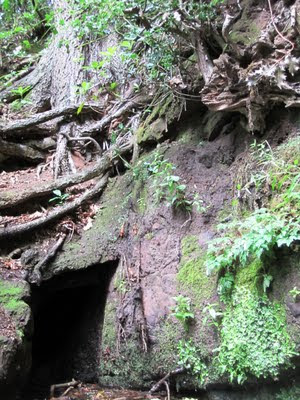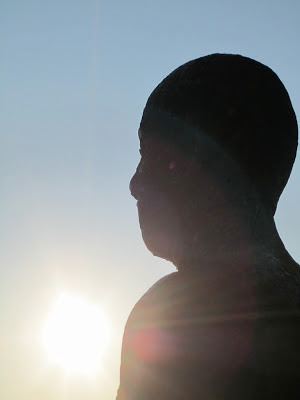Sacred Spaces - St Patrick's Well

I live on the Wirral, or in the Wirral or in Wirral depending upon your sense of geography. It's a small peninsular in the North West of England about 10 miles by seven; the River Dee separates us from the Roman city of Chester and the hills of North Wales; the River Mersey from the city of Liverpool and motorways Northwards.
Out to the West, Liverpool Bay leads into the Irish Sea and across to Ireland herself. Theoretically, I am told, it's almost an island as two ship canals come to a point where you can step from one to the other but the transport links of motorways and trains seem to defy that particular definition.
 |
| Across to the Welsh Hills |

The Wirral is still mostly suburban or countryside, originally part of a hunting forest that was planted in the 12th Century. It has been home to Roman, Saxon, Viking and Norman settlers. Pre-Roman it was home to a Celtic tribe called the Cornovii and there is evidence of Christian Celts from the the 5th and 6th Century in the round celtic churchyards in some of the local villages. From around 1200AD, Benedictine houses provided hospitals, supported a leper colony and provided a cross river ferry to and from Liverpool.
Like most locals I have been guilty of taking all of this for granted. I love living where I live but had made limited connections between my own spirituality and that that surrounds me preferring to go further afield to find sacred space until this summer when the opportunity simply wasn't there.
Thank to the nature of the landscape - the name Wirral comes from 'Wirheal' meaning bog-myrtle and suggests that the area was unsuitable for faming or building - the later creation of the hunting forest (being good for nothing else) and the fact that the Wirral has been (and still is in part) controlled by a few wealthy landowners - much of the countryside is unspoilt and protected as nature reserves .
St Patrick's Well isn't my nearest space but the one I would probably have never visited if I hadn't made the commitment to 'look at the ground beneath my feet'.
Part of the nature reserve - known as the 'Wirral Way' - travels through Bromborough, about five miles from my home.
Bromborough is one of the possible sites of an epic battle in 937, the Battle of Brunanburh, This is the first battle where England came together as one country, to fight the combined forces of the Norsemen and the Scots, and historians consider it the birthplace of England; this area is known as Dibbinsdale being centred around the River Dibbin. It's a mixture of meadow, riverside wetland and retains some of the ancient woodland of the 12th Century forest.
A breath of water and woodland surrounded by busy rush hour traffic; industrial units and a shopping outlet; I have driven past hundreds of times always on my way to 'somewhere else'.
This summer I turned into the sandstone lined lane; came to a halt in the tree encircled car park and took a look at the reserve map with the philosophical comment 'you are here'.
And on one of the many woodland walks there was a label and a small detour over a wooden bridge to a spot marked 'St Patrick's Well'.
St Patrick is reputed to have blessed this well, a scarce source of fresh water at the time, before his mission to Ireland in 432. Tradition or otherwise - this little corner has kept the title ever since.

Water has always been a sacred place in pagan and celtic spirituality. It would make perfect sense as the celts moved from pagan to Christian belief to have their source of water blessed by a man who embodied the strengths of the Druids and the Christian faith. You would wonder why it wasn't more famous; why, indeed, it didn't have it's own pilgrimage trail.
On seeing the sign I was a little hesitant to go further; what if it was neglected; vandalised; graffittied? What if it was a dreadful disappointment? What if it wasn't even there?
But it was; the walk lead downhill into a sandstone gorge. I found myself following a path below the surface of the modern road - beside the path the runoff from the rain mingled with the cascades of a brook that widened into small river. An arrowed sign that seemed to lead nowhere and there it was - a small squared-off entrance with markers of ancient masonery held in the grip of the deep roots of a beech tree. The water clear and bright above the debris of nature's leavings - seed pods, twigs, leaves and crab apples.

A certain neglectful elegance; a stillness; a sense of presence that was both spiritual and remarkably mundane.
There was nowhere to sit apart from the floor and the weather wasn't kind - leaning against the rocky outcrop the sound of the traffic above faded into a quiet humm. Any sense of moving on disappeared; stillness descended.
As dogwalkers and bmx bikers passed by there was a sense of timelines crossing; boundaries being pulled down. Sixteen hundred years plus of people coming to the Well; a place of life, of faith, of hope. And here I am today seeking the same refreshment of life.
Even if Patrick hadn't been here although there was a plain-ness and a practicality that would have certainly suited his spirituality - this place, this water was valued; was important; was sacred in a discrete way; sacred enough to remain inviolate. Somewhat returned to Creation; but why not? Why not?
God in the Everyday; the Everywhere - in a walk through woodland or sitting in a ancient church. Holy men and women have come before us whether or not we know their names - we are all part of a greater realm - we just have to take the time to step out of the normal way of things now and again.
This visit came at the end of the summer but brought a good lesson - the history I told you about at the beginning is as rich and as varied as any country; any part of this country. Perhaps we should first know where we come from?
As Mary Oliver says:
"Instructions for living a life.
Pay attention.
Be astonished.
Tell about it."
wordinthehand 2011









Comments
Thanks for calling by and commenting.
The reserve alone is lovely but strange to think that a place where you are standing could have had St Patrick standing there too - ad more than likely from the research I have done.
I'll be mentioning the Celtic Chapel as well in these blogs. How close to home is that - and I wouldn't be without it!
Regarding your comments - I would love to have such a group if I could get them to church...
What we do do is...
During Open Church on Thursdays there is an opportunity to talk if you want to.
Also after meditation on Tuesdays (in the chapel) we tend to have an informal discussion about what's going on in our lives and there is a support group every other Tuesday which started out as a carer's group - but aren't we all carers in some way? That talks a lot about the importance of our faith and God in everything we do.
The healing service on the Third Thursday often leads into discussion as well.
You'd be welcome to any of these
Thanks again and blessings
"A certain neglectful elegance; a stillness; a sense of presence that was both spiritual and remarkably mundane."
What an enchanting place! These are great pictures. God is present in the ordinary...I think it makes Him happy when we pause and remember Him in all things. :)